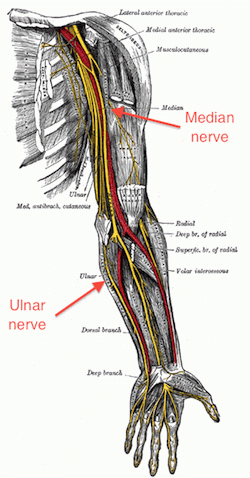The lifehand
Italian medical scientists working on the Lifehand Project have created the first bionic hand which is capable of communicating with the brain via the nervous system. The team, from Pisa’s Scuola Superiore Valdera Polo Sant’Anna, have been working on the Project for five years.
The hand, which has five fingers that can function independently of each other, works by means of four electrodes which are inserted into nerves in the remaining part of a patient’s arm. These create an interface which allows the patient’s nervous system to communicate with the hand, transmitting information and movement commands. The patient is also able to experiences tactile sensation.
Pierpaolo Petruzziello, an Italian-Brasilian man who lost his left arm below the elbow following a road accident, is the recipient of the hand. Doctors from the Campus Bio-Medico University in Rome carried out the delicate operation in November 2008, surgically attaching the bionic hand to Mr Petruzziello’s nervous system so that the prosthetic limb acts as an extension of the remaining part of his arm.
The electrodes were inserted into the median nerve at wrist level and the ulnar nerve in the forearm. After one year, there have been no complications or contraindications. Mr Petruzziello is able to close his fist, hold objects and move his fingers.
The Lifehand Project has thus far cost the EU 3 million dollars and now scientists will turn their attention to making such a hand a viable option for amputees.
Multiple sclerosis
 In what could be another medical breakthrough, Dr Paolo Zamboni of the University of Ferrara may have found the cause of multiple sclerosis [MS].
In what could be another medical breakthrough, Dr Paolo Zamboni of the University of Ferrara may have found the cause of multiple sclerosis [MS].
Dr Zamboni, a vascular surgeon, began researching MS fourteen years ago when his wife was diagnosed with the disease.
During his reading, he found references, dating back a century, to excess iron in the body being a possible cause of MS. He later discovered that, in 90% of the MS sufferers he examined, including his wife, the veins which should have been draining blood from the brain were malfunctioning in some way.
It is known that in MS immune cells cross the brain-blood barrier which in people without the disease keeps blood and cerebrospinal fluid separate. The cells then damage the myelin coating of the nerves. Dr Zamboni believes that iron is the cause of this and calls the condition “chronic cerebrospinal venous deficiency” [CCSVI] .
Dr Zamboni has performed surgery on his wife and other patients in Italy to unblock the cerebral veins.
Following the procedure many of the 65 patients’ MS symptoms have disappeared and 73% of them have been free of symptoms for two years. Now a team at the University of Buffalo in the US are going to test Dr Zamboni’s theories by replicating his earlier work on a wider sample of patients.
If Dr Zamboni’s theory is correct and MS is proved to be a vascular disease it will turn current medical thinking on its head, for the illness is generally thought to be an autoimmune one.
MS associations are urging caution at this stage but are keeping an open mind.










